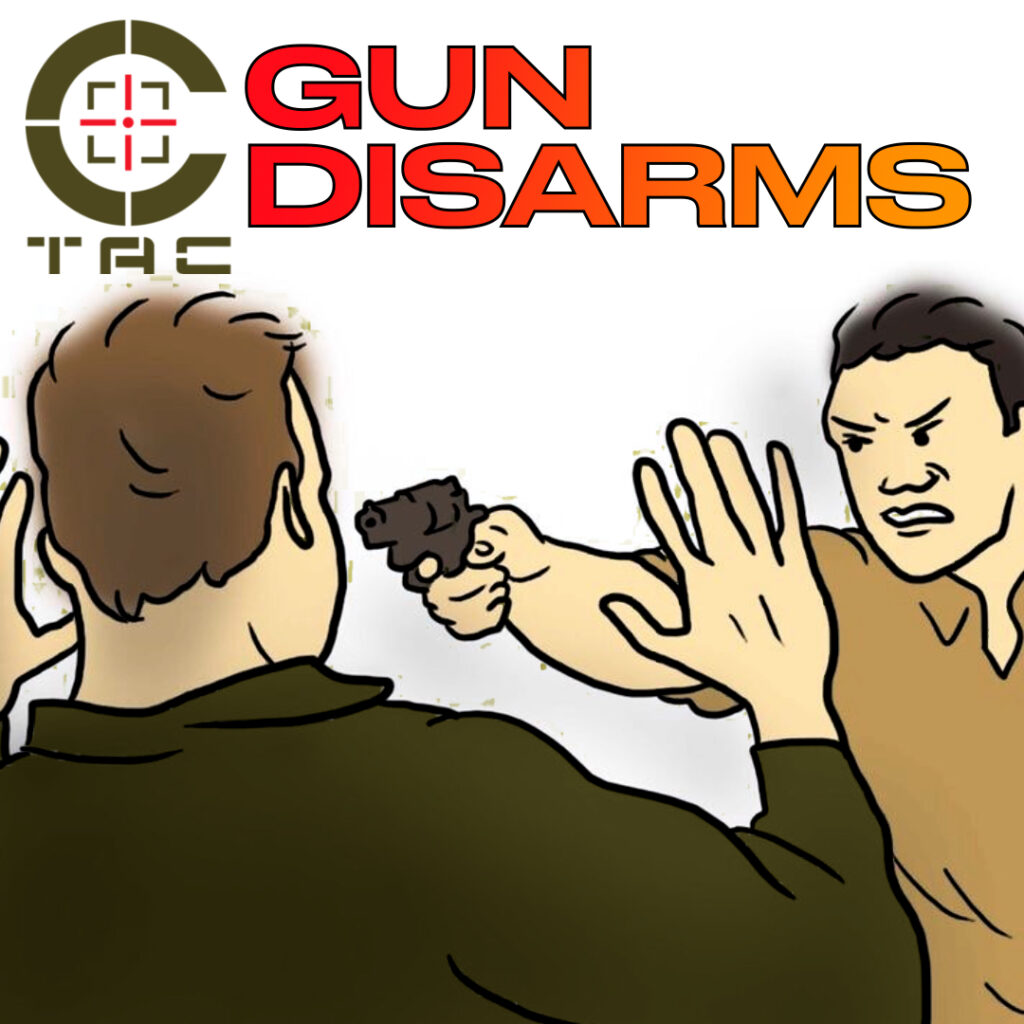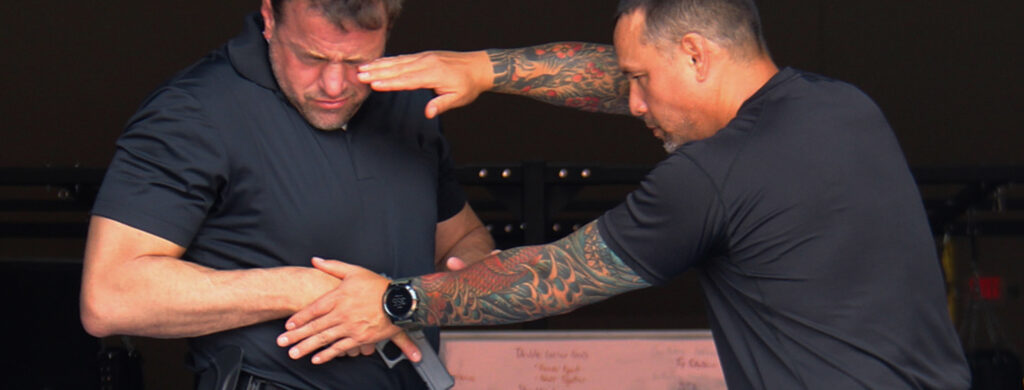
The C-Tac® Training philosophy
Introducing the C-Tac® System: Empowering You with Effective Self-Defense Skills
Are you searching for a comprehensive self-defense system that goes beyond physical techniques? Look no further than the C-Tac® System. Designed to equip individuals with practical self-defense skills, the C-Tac® System goes above and beyond by addressing various crucial aspects of personal protection. Let’s explore what sets the C-Tac® System apart and why it’s the right choice for those seeking a holistic approach to self-defense.
What Makes C-TAC So Different From Other Self-Defense Programs?

De-Escalation & Soft Control Techniques so fighting is an absolute last resort.

Legal Knowledge & Considerations so you can protect yourself legally in case of an altercation

Shielding Methods From the Keysi Fighting Method to protect yourself under stress

Non-Verbal Cues For Avoiding Attackers and dangerous situations before they arise

Defensive Tactics: In And Around A Vehicle against a wall or seated

Integration with your Every Day Carry (EDC) to blend with your empty hand.
The C-Tac® System seamlessly integrates Everyday Carry (EDC)
Integrating EDC principles into all of its training ensures that the tools and gear you carry daily are effectively utilized in self-defense scenarios. Our approach emphasizes the importance of being prepared with the right EDC items—whether it’s a knife, flashlight, or firearm—and knowing how to deploy them efficiently under stress. Throughout our training, you’ll learn how to incorporate your EDC into various defensive tactics, blending these tools with your skills to maximize your protection. By making EDC an integral part of your training, the C-Tac® System empowers you to be ready for any situation, using the gear you have on hand every day.
Situational Awareness
in the C-Tac® System, situational awareness is a fundamental component. Understanding your surroundings and being able to assess potential threats is crucial for personal safety. Our training focuses on honing your observation skills, enhancing your ability to identify and assess potential dangers, and developing a proactive mindset. We don’t just talk about situational awareness—we actively teach and practice techniques and drills designed to embed these critical skills into your nervous system.
Legal Compliance
Self-defense should always operate within the confines of the law. With the C-Tac® System, you’ll learn self-defense techniques that are not only effective but also legal. Our training emphasizes the importance of understanding the legal framework surrounding self-defense, ensuring that you are equipped with the knowledge to make informed decisions in high-stress situations.
Pre-Fight Social Exchange
Recognizing the signs of a potential confrontation before it escalates is essential. The C-Tac® System teaches you how to navigate pre-fight social exchanges, diffusing conflicts and de-escalating situations whenever possible. By mastering effective communication and conflict resolution skills, you can mitigate the need for physical confrontation. We ensure that everything we do remains within a framework that is both visually appropriate and socially acceptable.
Reasonable Force Continuum
Understanding the concept of reasonable force is vital for self-defense. The C-Tac® System follows a carefully structured force continuum, guiding you through appropriate responses based on the level of threat. By adhering to this continuum, you will learn to apply force proportionately and ethically, ensuring your actions are justified in the eyes of the law.
Integrated Firearms and Empty Hand Techniques
The C-Tac® System recognizes the role firearms play in personal protection. Our training not only covers empty hand techniques but also integrates firearm skills seamlessly. You will learn how to effectively combine the use of firearms with empty hand techniques, empowering you to handle diverse self-defense scenarios with confidence.
Practical Grappling for the Street
Ground fighting and grappling can be crucial in real-life altercations. The C-Tac® System strongly emphasizes practical grappling techniques specifically tailored for self-defense situations. Our training provides you with the necessary skills to defend yourself both standing up and on the ground, preparing you for a range of scenarios. In Tac we study 6 areas of training on the ground:
- Grappling: A fundamental study of grappling that blends techniques and strategies from Jiu-Jitsu, Combat Submission Wrestling (CSW), Catch Wrestling, and Shoot Boxing. This integrated approach emphasizes a more aggressive and effective style, designed to enhance your versatility and adaptability in combat scenarios.
- EDC Grappling: When weapon systems are introduced into the grappling environment, fundamental changes must be made. These adjustments impact everything from mechanics and techniques to movement itself. EDC Grappling addresses these critical shifts, ensuring your grappling skills are effective and adaptable in scenarios involving everyday carry (EDC) weapons.
- Anti-Grappling: Anti- or counter-grappling is the study of the grappling environment, focusing on understanding its dynamics and learning how to use them to your advantage in a fight. This approach equips you with strategies to neutralize or counter grappling techniques effectively, turning the tables on your opponent.
- Ground Fighting: When you incorporate weapons, striking, multiple opponents, and challenging environments like sidewalks or parking lots, the dynamics of ground fighting completely change. This approach prepares you for real-world scenarios where adaptability, awareness, and tactical thinking are essential for survival.
- Dog Boxing: Dog Boxing focuses on the art of “out of position” fighting, teaching you how to effectively defend and attack when you’re in unconventional or disadvantaged positions. It’s a specialized study designed to prepare you for real-world scenarios where perfect form and positioning aren’t always an option.
- Grounded Weapons Fighting: This isn’t about grappling with a firearm; it’s about applying the tactical principles typically used while standing—such as maintaining distance, achieving a superior angle, and controlling timing—all within the context of being on the ground. These strategies go beyond the limitations of traditional grappling to give you a more comprehensive approach to ground-based combat with weapons.

Two Trainng Options
What Our Clients Are Saying:
A Few Videos On C-Tac
The C-Tac Combat Blueprint Principle
Warriors Path Podcast On The C-Tac Blueprint
Fun With The Warrior Poet Team
C-Tac Counter Grappling With The WPS Team
Family Protection
Your family’s safety is a top priority. The C-Tac® System goes beyond individual self-defense by teaching you strategies and techniques to protect your loved ones. Whether it’s implementing effective home security measures or developing family-oriented defense plans, our training ensures you are equipped to safeguard your family in various settings.
Defensive Tactics in and Around a Vehicle
The C-Tac® System recognizes that personal safety extends beyond the confines of your home. We provide comprehensive training on defensive tactics specifically tailored for situations in and around vehicles. From carjackings to road rage incidents, our training equips you with the skills to protect yourself effectively in these environments.
Tactical Medicine
The C-Tac® System goes beyond self-defense by incorporating tactical medicine training. Our program introduces you to the skills to handle everyday emergencies, providing essential knowledge and techniques for immediate medical care. From wound management to recognizing signs of shock, you’ll learn life-saving interventions and the importance of situational awareness.
Disaster Preparedness
The C-Tac® System extends beyond self-defense to include vital disaster preparedness training, equipping you to handle emergencies, both natural and man-made. You’ll learn to identify potential threats, develop a comprehensive family emergency plan, assemble a customized disaster supply kit, and enhance your situational awareness during crises. Additionally, you’ll master basic survival skills such as fire-building, water purification, and first aid while fostering community preparedness by collaborating with neighbors and local organizations. This integrated approach ensures you have the confidence and skills to protect yourself, your family, and your community in any situation.
The C-Tac® System offers much more than just a self-defense program. It provides a comprehensive approach to personal protection, addressing situational awareness, legal compliance, communication skills, reasonable force, integrated firearms training, practical grappling, family protection, and defensive tactics in various settings. By enrolling in the C-Tac® System, you’re taking the first step toward empowering yourself with the knowledge and skills needed to navigate the complexities of personal safety. Don’t settle for anything less—choose the C-Tac® System for effective and well-rounded self-defense training.
Learn C-Tac Through The Online Student Video Academy

Interested in learning the C-Tac material as a student? The Video Academy is the ideal option for you!
C-Tac® strives to bring real-world tactical training to the civilian world.
Turn on any TV, watch the news, and you will see how changes in today’s world and our culture are creating the need for information and training that exceeds what a regular martial art school or Karate program has to offer.
The many benefits of martial arts in our culture have been proven over time and are more than mentioned here. Still, today’s martial arts community does not offer the experience, background, or knowledge needed to effectively meet the needs of industries that need more narrow, specialized applications.

Today, many “self-defense” instructors received their certification to teach by attending a three-day weekend seminar. Many groups in the martial arts that call themselves “martial arts practitioners” claim to offer solutions for today’s needs. Still, when you peel back the layers of the so-called “realistic programs,” they generally turn out to be just well-marketed nonsense that was pieced together to have something to sell to the unknowing civilian.
C-Tac will give you a well-rounded, effective personal protection plan that will cover intelligent threat assessment and planning, essential firearm use and close-quarter manipulation (Disarms, Weapon Retention), a practical and realistic defensive tactic (Self-Defense) that will work in multiple environments, including hallways, doorways, ground fighting, and in and around motor vehicles – to name a few.
The C-Tac system was developed to mentally and physically prepare you for dangerous situations by teaching you pre-fight conflict-resolution techniques and situational awareness. Both beginners and advanced students can train and become proficient in C-Tac.
You will study the urban weapons that allow you to take everyday objects and use them as tools in a threatening encounter. Also, as part of the urban weapons program, we show you how to use a bladed weapon or how to defend against the bladed weapon if someone attempts to use one on you.
There are two methods of study through the association. One is the student level which primarily involves studying with a certified instructor or studying virtually through the online video Training Academy on this website. Additionally, the student can also attend one of the many seminars that Coach Baker teaches around the United States annually. The second option is for the Professional Martial Artist that is looking to implement the C-Tac program into their schedule at the Academy. The second option is achieved through the instructor training program.

Two Trainng Options
Tactical Medicine: Empowering You to Respond in Emergencies
In addition to comprehensive self-defense training, the C-Tac® System goes above and beyond by incorporating tactical medicine into its curriculum. We understand that emergencies can happen anywhere, anytime, and being prepared to respond effectively can be a matter of life and death. That’s why our program includes essential training in tactical medicine, equipping you with the skills to handle common everyday emergencies that may arise.
Our tactical medicine training provides you with practical knowledge and techniques to assess and treat injuries in high-stress situations. Whether it’s a minor accident or a more serious medical incident, you’ll learn how to confidently and competently provide immediate medical care until professional help arrives. The goal is to empower you to become a first responder in emergency situations, making a positive difference in critical moments.
Within the C-Tac® System, we cover a range of essential topics in tactical medicine. You’ll learn basic life-saving techniques such as wound management, controlling bleeding and managing fractures or sprains. We’ll also educate you on recognizing signs of shock and providing initial stabilization. By understanding the principles of triage and prioritizing care, you’ll be better equipped to handle multiple casualties or incidents.
C-Tac Has Three Phases Of Training Up To The Black Level

Phase 1 “The Basics”
This phase marks the beginning of the student’s journey with C-Tac, introducing the foundational elements of our empty-hand defensive tactics system while emphasizing the application of techniques within a socially acceptable force continuum. Students also begin learning the principles of gun and knife disarming, building a solid foundation for practical self-defense. At C-Tac, we focus on principle-based education, a cornerstone of our unique training approach that distinguishes us from others in the field and ensures a deeper understanding and adaptability in real-world scenarios. Additionally, students develop critical mental processes for tactical awareness and environmental positioning, essential skills for effective situational readiness and self-protection.

Phase 2 “The Car Phase”
The C-Tac vehicle phase is an exciting next step in the training process, where students apply the foundational elements learned in Phase One to scenarios in and around motor vehicles. This includes fighting and handling firearms in vehicle environments while also incorporating tactical environmental placement to construct professional-grade driving routes between work and home. Students learn to address challenges such as choke points, roadblocks, and emergency driving, as well as implement counter-surveillance methods. Additionally, all firearm training at this stage is conducted with a focus on concealed carry.

Phase 3 “The War Phase”
The third phase of the system is a step up in Senecio training. The study introduces the fundamentals of the dog boxing program. The student will learn to apply previous material under an increased stress level. Along with this, the offensive use of knives and blunt urban weapons are introduced into the mix. We also begin a deeper dive into the Counter grappling and ground fighting program. The student also starts to study the methodology of fighting from an undesired position.
The C-Tac Combat Blueprint
The C-Tac Combat Blueprint

The Combat Blueprint helps the student to see what he is training in a big pitcher format, it keeps him focused on what the primal human will do in a stressful situation and allows us to organize our training in a more intelligent manner so we may achieve more in less time. The Blueprint also helps keep us focused on the high percentage areas and techniques that will be successful in a violent exchange.

Student Ranking Progression
Each phase is broken down into three levels of rank. These are the reparations that the students follow in the system. This allows for a structured advancement process as well as creates the ability to have organized testing and advancement for your students.
The C-Tac Acid “Stress” Principle

Start to fill the combat blueprint with the acid of high-stress levels, and the more advanced skills will start to fall apart. In other words, the more refined motor skills will leave you, so it is essential to choose wisely where you focus your training time to ensure the reactions and skills you need will be there when you need them most.

C-Tac employs a unique approach to teaching gun disarming, focusing on principle-based instruction rather than simply memorizing a list of techniques. We believe this method better prepares individuals to handle the complexities of such environments by emphasizing the fundamental requirements for surviving the disarming process. This principle-based approach provides students with a deeper understanding of what needs to happen and enables them to adapt their knowledge to various situations. Through this educational process, disarming evolves into an art form rather than just a collection of techniques.


